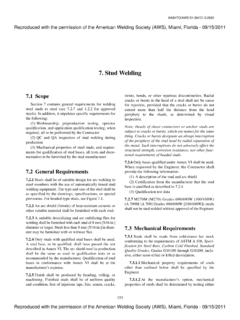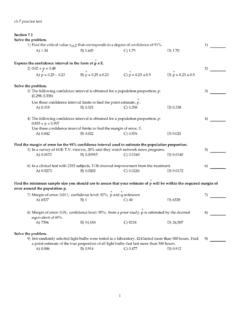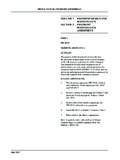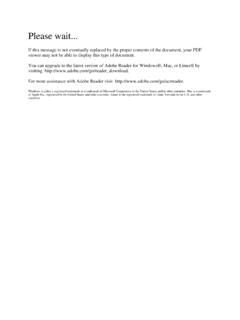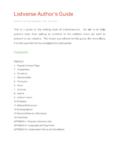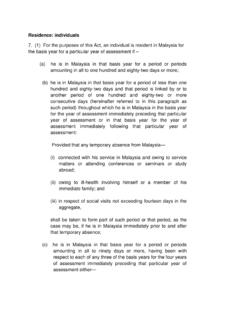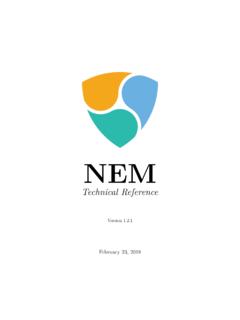Transcription of Section 7 Reports - The Custody Minefield
1 Copyright Michael Robinson 2015 Guides related to the law in England and Wales Page 1 Section 7 Reports A guide to welfare Reports in private family proceedings under Section 7 of the Children Act Contents 1. Introduction 2. The Children Act and Statutory Principles 3. Welfare Analysis 4. Understanding Post April 2014 Court Process and Important Practice Directions 5. Best Practice: Contents of a Section 7 report 6. Specific Learning Difficulties and Document Styles and Fonts 7. General Formatting Tips 8. Filing and Serving the Section 7 report 9. Attendance at Court 10. Human Rights and Child Arrangements 11. Powers of the Court 12. Developments in Case Law Appendix A: Welfare Checklist Appendix B: Child Arrangements Programme Process Flowchart Appendix C: Practice Direction 12B: The Child Arrangements Programme: Section 14: Reports Appendix D: Practice Direction 12J: Child Arrangements and Contact Orders: Domestic Violence and Harm: Sections 21 to 23: Reports Appendix E: Draft Court Order Wording: Section 7 Request To compliment this guide, we provide a blank Section 7 report template (click on image to download): We also provide a draft form with recommended content included in each Section (click on image).
2 Section 7 Guidance written in association with MAAPP, the Multi-Agency Application for the social work profession. Copyright Michael Robinson 2015 Guides related to the law in England and Wales Page 2 Section 7 Reports A guide to welfare Reports in private family proceedings under Section 7 of the Children Act 1. Introduction The Children Act 1989 (the Act ) is the principle legislation which governs private and public family law proceedings for children habitually resident in England and Wales. The Section 7 report derives its name from Section 7 of the Children Act 1989 which empowers the court to: 7(1)(a) ask an officer of the Service [CAFCASS] or a Welsh family proceedings officer; or (b) ask a local authority to arrange for - (i) an officer of the authority; or (ii) such other person (other than an officer of the Service or a Welsh family proceedings officer) as the authority considers appropriate, to report to the court on such matters relating to the welfare of that child as are required to be dealt with in the report .
3 2. The Children Act and Statutory Principles A number of guiding principles govern Children Act proceedings. First and foremost, the child s welfare must be the court s paramount consideration (commonly referred to as the Paramountcy Principle ). The Act also considers delay and the impact on child welfare: 1(2) In any proceedings in which any question with respect to the upbringing of a child arises, the court shall have regard to the general principle that any delay in determining the question is likely to prejudice the welfare of the child. A third statutory principle under the Act is the No Order Principle : 1(5) where the Court is considering whether or not to make one or more orders under this Act with respect to a child, it shall not make the order.
4 Unless it considers that doing so would be better for the child than making no order at all. 3. Welfare Analysis When considering arrangements which impact upon the child and their welfare, the court and those reporting to the court should make reference to the Welfare Checklist set out at Section 1(3) of the Children Act 1989 (see Appendix A). 4. Understanding Post April 2014 Court Process and Important Practice Directions In April 2014, Parliament s Children and Families Act made amendments to the Children Act 1989 and introduced a more formalised process for the management of cases. In private family law, this process is called the Child Arrangements Copyright Michael Robinson 2015 Guides related to the law in England and Wales Page 3 Section 7 Reports A guide to welfare Reports in private family proceedings under Section 7 of the Children Act Programme ( CAP ).
5 A flowchart exists for that process and is reproduced in Appendix B. Practice Directions issued by the court set out the detail of the process for case management. Social workers asked to undertake Section 7 reporting should be particularly aware of Practice Direction 12B which provides in-depth information in relation to proceedings under the new Child Arrangements Programme. Of particular note is Section 15 of Practice Direction 12B: The concept of the timetable for the child is introduced from public to private family law. Court proceedings should be timetabled so that the dispute can be resolved as soon as safe and possible in the interests of the child.
6 CAFCASS or, if appropriate, the local authority are encouraged to make recommendations for stepped phasing-in of contact arrangements (medium to longer term recommendations) within Section 7 Reports , so far as they are able. Section 15 also suggests, where active involvement or monitoring is required, the use of a monitoring order under Section 11H of the Children Act 1989 or a family assistance order. Practice Directions related to Section 7 Reporting Section 14 of Practice Direction 12B provides a process for reporting in proceedings related to child arrangements, and is reproduced in our Appendix C. Reporting in cases where domestic violence or abuse is at issue Social workers should also be intimate with Practice Direction 12J which relates to child arrangements proceedings where the issue of risk is raised in relation to domestic violence or abuse.
7 Sections 21 to 23 of Practice Direction 12J specifically relate to reporting and are reproduced in our Appendix D. 5. Best Practice: Contents of a Section 7 report The social worker should refer to the court order which calls for the Section 7 report in the individual case. A draft of the wording likely to be provided in the order is set out in Appendix E. The order should set out the matters which the report should address and include the date for filing and serving the report . The following information sets out best practice for Section 7 report writing. Header: The Header of the document should include the case number (taken from the court order requesting the Section 7 report ).
8 Footer: The Footer of the document should include the page number. Front Page: The front page should include: the name of the report ( Section 7 report ), the name of the court in which proceedings have been issued ( Luton Family Court ), the case number, the name and address of the social worker/ report author, Copyright Michael Robinson 2015 Guides related to the law in England and Wales Page 4 Section 7 Reports A guide to welfare Reports in private family proceedings under Section 7 of the Children Act a confidentiality statement. The Confidentiality Statement Wording should read: This report has been prepared for the court and should be treated as confidential.
9 Subject to rules of court it must not be shown nor its contents revealed to any person other than a party or a legal adviser to such a party. The relevant rules of the court to which the above statement refers are rules and of the Family Procedure Rules 2010 and Practice Direction 12G. Local Authority Name and Social Worker Qualifications: This Section should include: the name of the Local Authority; the name and qualifications of the Practitioner; the date the report was completed; the date upon which the report was filed with the court and sent to the parties (if unrepresented) or their solicitors. Nature of Proceedings: A brief description of the orders applied for by the parties.
10 Matters at Issue: The matters which the court has directed the Section 7 report covers. This should be taken from the order which requests the Section 7 report . Family Composition: The next Section should identify: the names and addresses of the parties and subject children, their dates of birth, relationships to each other, and ethnicity. It is important to check that no party applied to the court for their addresses to be withheld from the other party. Enquiries Undertaken This Section should include the nature of enquiries undertaken and the dates of enquiry including: List sources of information; Who was interviewed, whether face-to-face or by telephone; Observations of children, including contact; Telephone calls; Reasons if children not seen; Reasons if children not seen with either or both parties; Any other relevant enquiries including checks made (schools, health, probation, police) and any other previous involvement.
![CASE NO: [Enter Case Number] IN THE [ENTER …](/cache/preview/7/3/4/9/9/b/9/5/thumb-73499b95b3955a08e0fa90351f753733.jpg)
